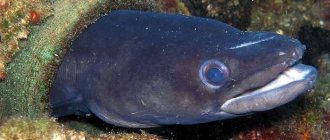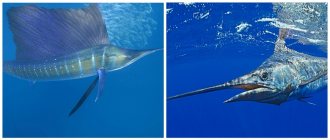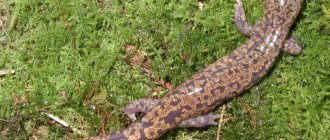Beluga is a fish that lives in fresh waters. It is a member of the sturgeon family and is highly valued in the fish farming industry. The caviar of this type of fish is the most expensive of all those presented on the world market. Recently, the beluga population has been rapidly declining, and therefore scientists are trying to learn how to breed fish in artificial conditions. It is noteworthy that the name of the fish translated from Latin means “pig”. This name fully corresponds to the fish, characterizing its lifestyle, appearance, behavior and feeding habits.
Origin of the species and description
Photo: Beluga
Beluga belongs to the chordates and is classified in the class of ray-finned fish, the order of sturgeons. The fish belongs to the sturgeon family, genus and species beluga. The beluga is the largest freshwater fish of all existing on earth. History describes cases where people caught really very large specimens. Some sources contain information that individual individuals weighing up to two tons were caught.
Video: Beluga
However, this information is not confirmed by any facts. In the process of evolution and population decline, the fish has significantly decreased in size. The largest individuals of this species were caught in 1700 and 1989. Their body weight was 800 and 970 kilograms, respectively.
In addition to the beluga, the sturgeon family includes the following fish: stellate sturgeon, sturgeon, and sterlet. Representatives of this family presumably appeared during the Eocene period, approximately 85-70 million years ago. This is evidenced by the discovered archaeological finds. Scientists suggest that the most ancient representatives of this family inhabited our planet about 200 million years ago, when dinosaurs walked the earth.
Surprisingly, fish have survived to this day without undergoing any external changes. Their body, as before, is covered with bone plates, which were necessary in order to survive in the conditions of that time.
Commercial value and catch
Today, fishing in natural reservoirs is prohibited. This rule applies in all countries where beluga is found. Poaching is punishable by large fines and even prison. To save the population, artificial nurseries are being set up in many areas, but breeding fish in them does not always give a positive result. All parts of the beluga are used, including meat, caviar, and skin. The meat is dried and sold frozen or canned. Albino beluga caviar is especially expensive, as the fish spawns it once every 100 years. Swim bladders are used to make wine clarifiers.
Did you know? From historical sources it follows that active fishing of beluga has been carried out since the 6th century BC.
Most often, hybrids are grown that are obtained by crossing beluga with other species of sturgeon: stellate sturgeon, sturgeon. The meat and caviar of these fish have less nutritional value, but they are also tasty and healthy products, but not so expensive. It is common to grow a hybrid from crossing sterlet and beluga - bester. Freshwater reservoirs are populated with fish.
How to breed and raise beluga at home
Every year there is increasing interest in breeding beluga hybrids at home. This makes it possible not only to eat high-quality healthy food, but also to receive an excellent income, since meat and fish are in considerable demand.
Important! Fry are released into a reservoir in warm weather or into a pool where the water temperature is at least +18
°
C.
The advantage of the grown hybrid fish is the fact that it adapts well to any conditions. Artificial ponds, lakes or indoor pools with pumping stations that ensure constant circulation and purification of water are suitable for breeding. The compressor ensures that the water is saturated with oxygen, and the presence of ultraviolet lamps promotes disinfection.
In addition to these basic points, a person who wants to raise beluga needs to take care of where to buy fry. It is better to buy them at specialized fish farms. Purchase specimens weighing at least 5 g. Adult fish can live at lower temperatures, +2...+4°C. During cultivation, you need to control the number of individuals in the reservoir. How many there should be depends on age and, accordingly, body weight. On average, there should be no more than 60 kg of fish per 1 m².
Appearance and features
Photo: What a beluga looks like
Fish is one of the particularly large marine inhabitants. Sexual dimorphism in the beluga is practically not observed; male and female individuals do not have significant visual differences between themselves. Its body weight can reach a ton, and its length is about four meters. There are witnesses who claim to have witnessed fish even six to seven meters long being caught. Beluga has a large, massive, stocky body.
The head part of the body actually has some similarities in appearance to a pig. The nose is somewhat blunt, reminiscent of a pig's snout. The sickle-shaped mouth is very wide, framed by massive lips. The beluga has no teeth, except for its fry. As they grow and become adults, they disappear. In the upper lip area there are antennae that hang down, reaching the lower lip. The beluga has small eyes. Vision is poorly developed, so the main reference point is a very acute sense of smell. The body of the fish is covered with dense, hard diamond-shaped scales that do not overlap each other. The body is painted in two shades: the back is gray with a brownish tint, the belly area is lighter, almost white or milky. The back area is covered with small spines. Zoologists say that this type of fish is long-lived. Due to their size, especially large individuals live for about a hundred years.
Use in cooking
The meat of the huge sturgeon is considered a valuable delicacy in Russian cuisine. Surprisingly tasty, nutritious and healthy dishes are prepared from it. Real masterpieces are obtained using any method of preparing fish:
- frying;
- drying;
- smoking;
- baking;
- steaming;
- grilling.
Beluga kebab is especially appreciated by gourmets: the incredibly tender meat, baked with smoke, cannot leave even the most sophisticated connoisseur of fish dishes indifferent.
Beluga meat contains a number of useful vitamins and amino acids.
The large representative of sturgeon is valued not only for its unique taste, but also for its range of beneficial health properties. Firstly, tender meat contains a large amount of easily digestible protein with low calorie content. The delicacy saturates the body with essential amino acids (they are not synthesized and can only be obtained from certain foods).
Secondly, sea life, like other seafood, contains fluorine, calcium and other trace elements necessary to maintain healthy bones, hair, nails and beautiful skin. Potassium, which is part of meat, supports the heart muscle, preventing heart attack and stroke. Thanks to vitamin A, consumption of valuable sturgeon improves visual acuity, and vitamin D prevents osteoporosis and rickets.
Behavior
Beluga is a fish that is distinguished by its peculiar behavior among representatives of its species. There are two forms that differ in the period of spawning migrations and the duration of stay in fresh water. At sea, the beluga prefers to lead a solitary lifestyle, and while in the river, it gathers in numerous flocks. This is due to the fact that it comes to rivers to spawn, and in the sea it only feeds and develops.
Diet
And she begins to lead this lifestyle quite early. The diet includes fish such as herring, carp, pike perch and gobies. At the same time, the beluga is not averse to swallowing its relative if it is small in size and hesitated somewhere.
In addition to fish, it is capable of swallowing shellfish, waterfowl and even baby seals if it reaches the appropriate size. Experts have come to the conclusion that the migrations of the beluga are associated with the migrations of its food supply.
Nutrition and behavior in nature
Beluga looks scary, and for good reason. She does not disdain any inhabitants of reservoirs. Anyone who approaches the fish at an extremely close distance instantly finds themselves in its huge stomach. Omnivorous sea giants most prefer in their diet:
- sea gobies;
- herring;
- anchovy;
- all representatives of the carp family;
- crucian carp;
- rudd;
- roach.
The beluga is not squeamish and can eat everything that comes its way.
In nature, there are cases when the beluga eats water rats and mice. When some individuals were opened, even their own young were found in the stomach cavity, which had recently emerged from the eggs. Growing young animals can feed on mollusks and various invertebrates, as well as sprat and roach.
Spawning
One of the subspecies spawns earlier than the other. Its spawning period coincides with the maximum spring water level in the rivers. At the same time, the water temperature can reach +8-+17 degrees. Another subspecies comes from the seas to spawn around August. After this, individuals overwinter in deep holes and begin to spawn in the spring. Beluga begins to spawn at the age of 15-17 years, after reaching a weight of about 50 kg.
Beluga lays eggs at a depth of at least 10 meters. At the same time, she chooses areas with a hard rocky bottom and a fast current, which provides the spawning site with oxygen.
Fish that live in the seas enter rivers to spawn, and are therefore called migratory. While in fresh water, it continues to actively feed. After spawning, as soon as the eggs hatch into fry, they return to the sea with them. Beluga comes to spawn once every 2-3 years. At the same time, there is a species that lives in rivers permanently and does not migrate over long distances.
Habitat
Just a century ago, this large predator lived in the Black, Caspian, Adriatic and Azov seas. Beluga today can be observed in the river called the Danube, in the Black Sea basin, and in the Ural River in the Caspian Sea basin. As for the Sea of Azov, only one species lives there - the Azov beluga, and that is artificially bred. In order to give birth and continue their race, this species of Sturgeon actively begins to move from seas to rivers. This is where the females spawn. Where is the beluga in Russia: The inhabitants of the Caspian Sea go to large rivers to leave their offspring: Terek, Volga, Ural, Kura. On the territory of Russia in the Volga, it was caught from the largest belugas.
The fish weighed 1.5 tons. Residents of the Sea of Azov swim to the Don River to reproduce, and less often to the Kuban. For some time now, valuable commercial fish have not been found in the waters of the Volga. All due to the fact that the fish lift, which was built at the Volgograd hydroelectric complex, was no longer used due to its poor functioning. The Black Sea beluga lives in the Danube River, there are 6 species there, the Dnieper and the Dniester (off the coast of Yalta). Large belugas are found in the Black Sea. The fish was spotted near Kiev, because during spawning it can rise high in the waters of the Dnieper.
Beluga roar
Everyone knows the common expression “to roar like a beluga,” but it can greatly mislead a person. The loud sounds mentioned earlier are made by the beluga whale, aka a species of white toothed whale. The phraseological unit itself was used several centuries ago, and both designations were used for a white mammal.
@ rostislavstefanek.seznam.cz -depositphotos.com
Head
The head is massive, large, wide near the body. There is a short pointed snout on the head. The snout is soft on the sides and on top; there are no bony scutes on it. The mouth is located below the snout, large, sickle-shaped when closed, crescent-shaped when open, framed by thick fleshy lips, the lower lip is interrupted.
On the underside in front of the mouth are four antennae, laterally flattened with leaf-like appendages. There are no teeth, only fry and young fish have teeth; as the fish grows, they disappear. The eyes are small, located on the top of the head, and vision is poorly developed. The beluga navigates mainly using its keen sense of smell and sensitive antennae near the mouth.
Beluga sizes
Beluga has the largest size among all sturgeon fish. If we consider it a freshwater fish, then it can be classified as the largest fish living in rivers. Under natural conditions, it can grow up to 3-4 meters and weigh 800-1000 kg. Several cases of capturing particularly large specimens have been described:
- In 1922, a beluga weighing 1200 kg was caught in the Caspian Sea, and in 1924 - weighing 1000 kg.
- In 1939, a beluga weighing 750 kg without caviar was caught in the Temryuk Gulf of the Sea of Azov.
- In 1970, a female beluga weighing 800 kg was caught in the Volka River delta, containing 112 kg of caviar.
- In 1989, a beluga was caught in the same place; its length was 4 m 20 cm and its weight was 966 kg. A stuffed animal of this fish is in the Astrakhan museum.
- In 2013-2015 Several belugas weighing 125-130 kg were caught in the Ural River.
Currently, fish of this size are not found. The average size of beluga, which is caught for commercial purposes, is 80-150 cm in length. The weight of such fish is about 20-30 kg.
Reproduction and offspring
Beluga begins to breed late . Thus, males are ready to breed at the age of at least 12 years, and females do not breed until they are 16-18 years old.
Females of the Caspian beluga are ready to continue their race at the age of 27: only by this age do they become fit for reproduction and accumulate sufficient weight for this. Most fish die after spawning ends. But the beluga spawns repeatedly, albeit with intervals of two to four years.
In total, 8-9 spawnings occur during its long life. She spawns on a sandy or pebble bottom, where there is a fast current, which is necessary for a constant flow of oxygen. After fertilization, the eggs become sticky and stick to the bottom.
This is interesting! A female beluga can lay several million eggs, and the total mass of eggs can reach up to a quarter of the weight of the fish itself.
In 1922, a five-meter beluga weighing more than 1200 kg was caught in the Volga. It contained approximately 240 kg of caviar. The hatched larvae, which later turn into fry, set off on a difficult journey - in search of the sea. “Spring” female belugas, entering the river from mid-winter until the end of spring, spawn in the same year. “Winter” beluga, in order to find and occupy a place convenient for spawning, comes to the rivers in August and remains there to winter. It spawns only the next year, and before that it lies in a kind of hibernation, sinking to the bottom and becoming covered with mucus.
In May or June, the “winter” beluga comes out of hibernation and spawns. Fertilization in these fish is external, like in all sturgeons. The eggs attached to the bottom of the reservoir mostly become prey for other fish, so the survival rate among juvenile beluga is very low. Beluga cubs live in shallow waters warmed by the sun's rays. And after they grow up enough, they leave their native rivers and go to sea. They quickly increase in size and by the age of one year their length becomes approximately equal to a meter.
Return to content
Beluga caviar
Beluga caviar is gray-black in color with a silvery tint, has a distinct smell and delicate taste. Beluga caviar is one of the most valuable and expensive in the world. The cost of beluga caviar on the market is simply prohibitive: 100 grams of caviar costs 20,000-30,000 thousand rubles.
Beluga caviar is a very expensive delicacy, which not everyone can try due to its high cost. This defines it as an elite product. In addition, it has the highest taste qualities. Its calorie content exceeds the calorie content of beluga meat. It contains a large amount of proteins.
Previously, when there was no ban on sturgeon fishing, beluga was caught in huge quantities precisely for the purpose of catching and selling caviar. This, coupled with other negative factors, led to a sharp decline in the number of these fish in natural conditions.
Currently, beluga fishing is prohibited. Its caviar is obtained only from fish grown under artificial conditions. Since the beluga reaches sexual maturity only at 20-25 years of age, this leads to a large expenditure of time, effort and money on its breeding. This influences the very high final cost of caviar.
But, despite the official ban on beluga fishing, poachers catch beluga and extract valuable caviar for profit.
Why are sturgeon valued?
Caviar and meat of all types of sturgeon have always been in price. Among ancient peoples, it was served only to kings, emperors and the highest nobility.
The protein of the meat of these fish is completely absorbed by the body. Fish is rich in the content of the entire set of vitamins and microelements, amino acids necessary for proper nutrition. It contains fluorine in large quantities. It is necessary for bone growth. Therefore, it is very useful for children to eat caviar and sturgeon meat.
The most valuable fish glue is made from the air bubble. It is used in medicine, in printing when printing books, by jewelers for gluing gold leaf, and in the restoration of ancient paintings.
To restore the stock of these valuable fish, it is necessary to study their living conditions and habits, treat nature with care, and comply with all catching standards.
Beluga's enemies
An adult beluga living in the sea has practically no natural enemies. It is too large for other fish to hunt. Another thing is the eggs, larvae, fry and young beluga.
Caviar and larvae become prey for other small fish: gudgeon, silver bream, bream, catfish, sterlet, sturgeon, young beluga, perch, pike. Ironically, the beluga itself is one of its main enemies. Cannibalism is more common among belugas than among all other fish species. Grown-up belugas destroy their own small relatives and caviar, eating them in huge quantities.
The main enemy of an adult beluga is humans. Before the ban on catching beluga during the spawning season, 1.5-2 thousand tons of beluga were caught annually on the Volga alone.
And although fishing for these fish is now prohibited, poachers are still significantly reducing their numbers.
Breeding red fish
The construction of power plants on rivers and environmental damage have significantly reduced the number of this fish. Most of its modern reproduction occurs in fishing factories and private fish farms.
Fish hatcheries mainly breed beluga, stellate sturgeon, thorn, and sturgeon.
Adult fish are caught in rivers, brought to the factory in special containers, and caviar is obtained from them. From it, larvae emerge in the hatchery workshops. They are placed in pools and raised to the state of fry 1.5 - 3 cm long in clean running water.
Sturgeon farming is considered a promising business.
Population and species status
The beluga population has declined enormously over the past 80-100 years. The catastrophic decline in the number of this fish began at the beginning of the 21st century. And now there is still a steady decline in its numbers. Beluga is listed in the Red Book of the Russian Federation and the International Red Book as an endangered species. Over the past 70 years, the number of beluga sturgeons has decreased by 90%.
You may be interested in: Heh from pike
The rapid decline in beluga numbers is influenced by several factors:
- long period of reaching sexual maturity - 15-25 years.
- Commercial catch of beluga sturgeon on a catastrophically large scale.
- Poaching.
- Construction of dams and hydroelectric power stations on rivers where beluga sturgeon spawn. The erection of artificial obstacles to the movement of fish to spawning grounds leads to the fact that the beluga refuses to spawn altogether and the eggs are absorbed in the body of the females, or she has to spawn in unsuitable places, which leads to the death of most of the eggs.
- Pollution of rivers and seas by industrial wastewater, organic and mineral fertilizers, and pesticides used in agriculture. Beluga is very sensitive to water quality, so any water pollution in the river has a detrimental effect on the fertility of the fish and the survival rate of the eggs.
The complete loss of natural spawning grounds for the Azov beluga led to the almost complete extinction of this fish population.
Problems of species conservation
According to the International Sturgeon Research Institute (USA), over a period of time not exceeding 50 years, the beluga population has decreased by approximately 90%. The research results are disappointing. If in the middle of the 20th century more than 25,000 individuals rose to spawn in the Volga, at the beginning of the new century, their number no longer exceeded 3,000.
The saddest thing about this is that despite the development of a set of measures to preserve the population of the species, the beluga population continues to decline.
The main reasons for the decrease in the number of belugas can be identified as follows:
- Construction of hydroelectric power stations. Hydraulic dams prevent fish from reaching their spawning grounds. Thus, the construction of such dams completely cut off the beluga migration routes to the rivers of Austria, Croatia, Hungary and Slovakia.
- Uncontrolled poaching . High prices for meat and, especially, caviar create a huge demand for fishing among dishonest fishermen. The largest individuals are caught, which are capable of producing significantly more numerous offspring. Thus, this problem led to the complete extermination of the Adriatic beluga population, and this subspecies is now considered extinct.
- Ecological problems . Beluga is a long-living fish and various toxic substances from human activities, such as pesticides, can accumulate in its body. Many ichthyologists agree that this may affect its reproductive functions.
I would like to believe that in the near future it will be possible to preserve such a unique biological species, the legendary king fish.
Features of character and lifestyle
Despite their rather large dimensions, the fish are mobile, prone to migration over long distances. The main habitat is the sea, but during the spawning season belugas go to the mouths of large rivers.
According to the form and type of migration, belugas are divided into two categories:
- spring Fish migrate to rivers in the first half of spring.
- winter The influx of fish to the Volga is observed in the autumn.
The number is dominated by winter fish, which actually overwinter in depressions on the bottom, and with the onset of spring they immediately begin to spawn. After the end of spawning, the predator returns to its natural habitat - the sea. Orients itself in space, relying on a very keenly developed sense of smell. When living in the open sea, the beluga leads an isolated, solitary lifestyle. During migration to rivers it gathers in numerous groups.
With the onset of cold weather, the beluga sinks to depth and lies in deep-sea holes at the bottom. Plunging into hibernation, she waits out the cold. With the onset of warmth and spring, the fish awaken and spawning begins. During this period, some individuals tend to change their usual behavior, lifestyle and diet. However, with the end of the breeding season, they return to their usual way of life.
Interesting Facts
- This is one of the longest living fish. Life expectancy can reach more than 100 years.
- Parents do not care about their offspring in any way. On the contrary, after some time they can eat the slowest offspring.
- During the course, fishermen often watch these sturgeons jump high out of the water. It's an impressive sight considering its size. There is still no clear explanation for this phenomenon.
- These fish, like sharks, anatomically have no bones. Its skeleton consists exclusively of cartilage, only which becomes tough and hard over time.
- Females can contain a very large amount of eggs. The capture of an individual weighing 1200 kg, from which almost 150 kg of caviar was extracted, is documented.
- In the Far East, in the Amur River basin, a closely related species lives - kaluga, which also reaches enormous sizes - up to 5 meters in length and 1000 kg. weight. Attempts by scientists to cross species ended in failure.











